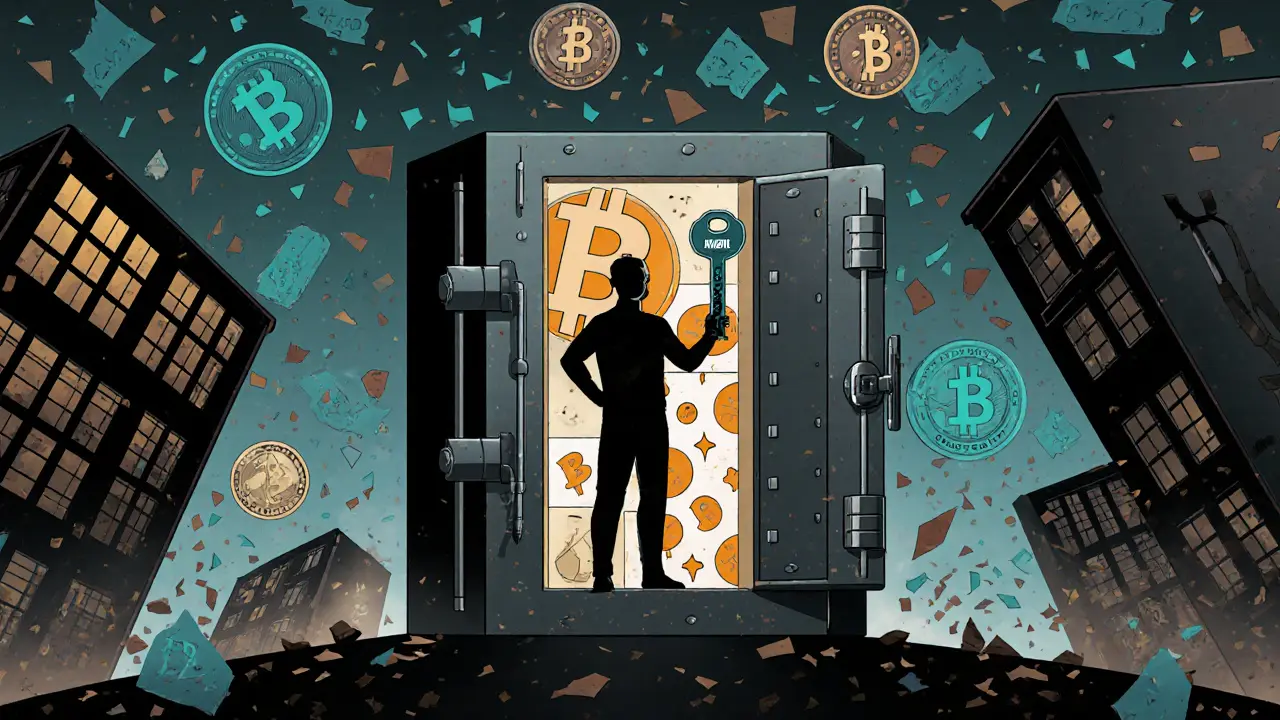Karura Swap Crypto Exchange Review: DeFi on Kusama Explained
 Apr, 2 2025
Apr, 2 2025
Karura Swap Calculator
Estimate Your Swap
Calculate how much you'll receive on Karura Swap with just a 0.3% trading fee. Pay fees in any token you hold.
Your Estimate
Most crypto users know about Uniswap or PancakeSwap, but if you're deep into Polkadot or Kusama, Karura Swap is the exchange you actually need to understand. It’s not just another decentralized exchange - it’s the heart of DeFi on Kusama, built by the same team behind Acala on Polkadot. This isn’t a platform for casual traders. It’s for those who want to stake, lend, borrow, and trade without giving up control of their assets - all with near-zero fees and cross-chain flexibility.
What Is Karura Swap?
Karura Swap is the automated market maker (AMM) at the core of the Karura network - Kusama’s flagship DeFi hub. Unlike centralized exchanges like Binance or Coinbase, Karura Swap runs entirely on smart contracts. You don’t deposit funds into a company’s wallet. You connect your wallet - like Polkadot.js, MetaMask, or Talisman - and trade directly with liquidity pools. No KYC. No middleman. Just code.
It’s built on Substrate, the same framework that powers Kusama and Polkadot. That means it’s natively compatible with assets from both ecosystems. You can swap KSM, DOT, and tokens from parachains like Moonbeam or Acala, plus ERC-20 tokens from Ethereum via cross-chain bridges. The platform is also EVM-compatible, so Ethereum-based dApps can run on Karura without major changes.
How Karura Swap Works
Karura Swap uses liquidity pools, just like Uniswap. Users deposit pairs of tokens - say, KSM and kUSD - into a pool. In return, they get liquidity provider (LP) tokens. Every time someone trades using that pool, a small fee is charged, and that fee gets distributed back to LPs. That’s your passive income.
But Karura doesn’t stop at swapping. It’s a full DeFi suite. You can:
- Stake KSM and receive LKSM, a liquid staking token that earns rewards and lets you trade or lend while your KSM is staked.
- Borrow kUSD, the platform’s native stablecoin, by locking up crypto as collateral (you need to over-collateralize - usually 150% or more).
- Lend your tokens to earn interest directly on the platform.
- Trade with fees paid in any token you hold - no need to buy KAR just to pay gas.
This flexibility is rare. Most DEXs force you to pay fees in their native token. Karura lets you pay in KSM, DOT, ETH, USDC, or even kUSD. That’s a big deal for users who don’t want to juggle multiple tokens just to make a trade.
Trading Fees and Costs
Karura Swap’s fees are among the lowest in DeFi. Trading fees are typically 0.3%, which matches industry standards. But here’s the twist: you can pay those fees in any token in your wallet. No need to buy KAR tokens to cover gas. The protocol automatically converts a small amount of whatever token you’re using into the required fee, using a built-in price oracle.
Liquidity providers earn two types of rewards:
- Trading fees from swaps in their pool
- Stability fees from kUSD loans - borrowers pay interest, and that interest is shared with LPs
There’s also a KAR token - Karura’s native governance and utility token. It’s not required to use the platform, but holding it lets you vote on upgrades and earn bonus rewards in some liquidity pools. As of October 2025, KAR trades around $0.023, with most forecasts predicting minimal movement due to its niche ecosystem focus.

Who Is Karura Swap For?
This isn’t a platform for beginners. If you’re new to crypto, stick with Coinbase or Kraken until you understand wallets, private keys, and smart contract risks.
Karura Swap is built for:
- Polkadot/Kusama ecosystem users who want deeper DeFi tools
- Traders who want cross-chain swaps without wrapping or bridging manually
- Liquidity providers looking for yield beyond just trading fees
- Developers building EVM-compatible apps on Kusama
It’s also ideal for users who dislike centralized exchanges. If you’ve ever worried about a platform freezing your funds or going offline, Karura’s decentralized structure gives you full control. Your assets never leave your wallet.
Traffic and Market Position
Karura Swap isn’t a giant. According to traffic data, it gets about 972 monthly visits - almost all organic. That puts it at #447 out of 583 crypto exchanges in organic reach. Compare that to Uniswap, which gets millions of visits per day.
But traffic doesn’t tell the whole story. Karura’s audience is small but highly engaged. The bounce rate is 35%, meaning most visitors explore more than one page. Average visit duration is just over a minute - long enough to swap tokens, check yields, or review liquidity pools. These numbers suggest users aren’t just clicking around - they’re actively using the platform.
Its low traffic reflects its purpose: Karura isn’t trying to compete with Binance. It’s serving the Kusama community, which is intentionally experimental and technical. Think of it as the underground lab where Polkadot’s future features are tested.
Security and Regulation
Karura Swap has no regulatory licenses. It doesn’t need them. It’s a decentralized protocol. There’s no company behind it to sue, shut down, or freeze accounts. That’s both a strength and a risk.
Smart contracts have been audited by reputable firms like CertiK and OpenZeppelin. The code is open-source, and all transactions are public on the Kusama blockchain. That means anyone can verify how it works. But audits don’t guarantee safety. Bugs happen. If you send funds to the wrong address or interact with a malicious token, there’s no customer service to help you.
Users must manage their own security. Use a hardware wallet. Never share your seed phrase. Double-check contract addresses before approving transactions. One typo can cost you everything.

Pros and Cons
| Pros | Cons |
|---|---|
| Zero-KYC trading | Low traffic means smaller liquidity pools |
| Pay fees in any token you hold | Not beginner-friendly |
| Liquid staking with LKSM | KAR token has limited utility outside governance |
| EVM compatibility for Ethereum dApps | Only active on Kusama - not Polkadot |
| Integrated lending and borrowing | Minimal price movement on KAR token |
How to Get Started
Here’s how to use Karura Swap in five steps:
- Get a wallet that supports Kusama: Polkadot.js, Talisman, or MathWallet.
- Fund it with KSM or another Kusama-based token.
- Go to apps.karura.network and connect your wallet.
- Choose a trading pair - KSM/kUSD, DOT/kUSD, or any supported token.
- Swap, add liquidity, or start earning - no extra steps needed.
If you want to lend or borrow, click on the "Lending" tab. Deposit collateral, then borrow kUSD. You can repay anytime with interest. If your collateral drops too low, your position gets liquidated - that’s the risk.
Final Verdict
Karura Swap isn’t for everyone. If you want to buy Bitcoin with a credit card, look elsewhere. But if you’re already in the Polkadot/Kusama world and want to unlock DeFi without leaving your ecosystem, this is one of the best tools available.
It’s not flashy. It doesn’t have celebrity endorsements or viral marketing. But it’s functional, secure, and deeply integrated into Kusama’s infrastructure. For users who value control, cross-chain flexibility, and true decentralization, Karura Swap delivers.
Just remember: in DeFi, you’re your own bank. Do your homework. Start small. And never invest more than you can afford to lose.
Is Karura Swap safe to use?
Karura Swap is as safe as the code it runs on. Its smart contracts have been audited by CertiK and OpenZeppelin, and all transactions are public on Kusama’s blockchain. But since it’s decentralized, there’s no customer support. If you send funds to the wrong address or interact with a malicious token, you lose them permanently. Always double-check contract addresses and use a hardware wallet.
Do I need KAR tokens to trade on Karura Swap?
No, you don’t need KAR tokens to swap, stake, or lend. You can pay trading fees in any token you hold - KSM, DOT, USDC, ETH, or even kUSD. KAR is only required if you want to vote on governance proposals or earn bonus rewards in select liquidity pools.
Can I use Karura Swap on Polkadot?
No, Karura Swap runs only on Kusama, which is Polkadot’s test network. The equivalent platform on Polkadot is Acala Swap. They’re built by the same team, but they operate on separate chains. If you’re on Polkadot, use Acala. If you’re on Kusama, use Karura.
What’s the difference between LKSM and KSM?
KSM is the native token of Kusama. When you stake KSM on Karura, you receive LKSM - a liquid staking token that represents your staked KSM. LKSM can be traded, lent, or used as collateral while your KSM continues earning staking rewards. This lets you earn yield without locking up your assets.
Is Karura Swap better than Uniswap?
It depends on your needs. Uniswap is larger, has deeper liquidity, and supports more tokens - but only on Ethereum. Karura Swap is smaller but offers native cross-chain access to Kusama and Polkadot assets, plus integrated staking and lending. If you’re already in the Polkadot ecosystem, Karura is more efficient. If you’re trading mainstream tokens like ETH or USDT, Uniswap is easier.
DeeDee Kallam
November 1, 2025 AT 04:09i just tried karura swap and my wallet went poof 😭 no customer service, no refund, just silence. why do people trust this?
alvin Bachtiar
November 1, 2025 AT 11:06Let’s be real - Karura Swap isn’t for the faint of heart. It’s the crypto equivalent of building your own jet engine in your garage. Zero-KYC? Check. Pay fees in ANY token? Genius. But that 972 monthly visits? That’s not a bug - it’s a feature. This isn’t trying to be Uniswap. It’s the underground lab where Polkadot’s future is forged. If you’re here, you already know what you’re doing. The real question is: why aren’t you using it yet? 🚀
Bhavna Suri
November 2, 2025 AT 00:33This is too complicated. I just want to buy crypto. Why so many steps?
Elizabeth Melendez
November 3, 2025 AT 08:04Okay but can we talk about how LKSM is pure magic? 🤯 You stake KSM, get LKSM, and now you can trade it, lend it, use it as collateral - all while still earning staking rewards? That’s like getting paid to sleep. And the fact that you can pay fees in USDC or DOT? No more scrambling to buy KAR just to swap. I’ve been using this for 6 months and I’ve never paid a single gas fee in KAR. It’s such a thoughtful design. If you’re even slightly into Kusama, this is non-negotiable. Stop scrolling and start swapping. You’ll thank me later. 💪
Phil Higgins
November 4, 2025 AT 01:28There’s a quiet elegance here. Not the loud, hype-driven chaos of mainstream DeFi - but something deeper. Karura doesn’t scream for attention. It simply exists as a functional, self-sustaining mechanism within the Kusama ecosystem. The low traffic isn’t failure - it’s intentionality. It serves a niche, not a crowd. And in that niche, it’s flawless. Most platforms try to be everything to everyone. Karura knows its role. That’s rare. That’s worth respecting.
Genevieve Rachal
November 5, 2025 AT 07:58Low traffic = low liquidity = slippage nightmares. And don’t even get me started on KAR’s $0.023 price - that’s a graveyard token. If you’re not trading in massive volumes, you’re just subsidizing the whales. Also, ‘EVM-compatible’? Cute. But if you’re actually deploying dApps here, you’re signing up for 3x the debugging and 0x the community support. This isn’t DeFi - it’s a hobby project with a whitepaper.
Eli PINEDA
November 6, 2025 AT 09:03wait so if i swap ksm for kusd do i get kusd back if i unstake? or is it locked? i’m confused lol
Debby Ananda
November 6, 2025 AT 11:50Of course it’s ‘not for beginners.’ Only the truly enlightened should dare to interact with the sacred contracts of Kusama. 🙏 I mean, if you need KYC and customer support, you probably still think Bitcoin is a meme. I use Karura because I understand that true decentralization requires sacrifice. Also, I only trade with hardware wallets and 17 layers of multi-sig. You? Probably still use MetaMask on your phone. 😇
Vicki Fletcher
November 6, 2025 AT 15:58Wait - so you can pay fees in USDC? That’s... actually brilliant? I didn’t realize that. I thought you had to buy KAR? And LKSM is liquid staking? So you’re not locked in? Wow. I’ve been using Acala on Polkadot and didn’t even know Karura did this too. I might switch. Thanks for explaining - I was skeptical but now I’m curious. 😅
Jeremy Jaramillo
November 6, 2025 AT 18:43For everyone saying ‘this is too niche’ - remember, Ethereum was once niche too. Karura isn’t trying to replace Uniswap. It’s giving Kusama users a native, seamless way to interact with DeFi without bridging, wrapping, or trusting third parties. That’s huge. If you’re in the ecosystem, this is the toolkit. If you’re not? Cool. Stay where you are. But don’t knock it because it doesn’t have 10 million users. Quality over quantity, always.
Sammy Krigs
November 8, 2025 AT 06:37is karura even real or is it a rug pull? i saw someone on twitter say the dev team vanished last month? anyone know?
naveen kumar
November 10, 2025 AT 02:26Of course it’s ‘secure.’ All decentralized protocols are. That’s why 98% of crypto users have lost everything. The audits? PR. The open-source code? A distraction. The real truth? The team is just testing how fast they can drain liquidity before the next bear market. KAR’s price is stagnant because it’s already dead. They’re just waiting for the last fools to deposit.
Bruce Bynum
November 10, 2025 AT 10:39Just tried it. Took 5 minutes. Swapped KSM for kUSD. Staked some. Got LKSM. All good. No drama. No fees in KAR. Perfect for what I need. If you’re in Kusama, do it. Simple.
Wesley Grimm
November 10, 2025 AT 20:36972 visits? That’s not a platform. That’s a ghost town. If the liquidity is this thin, you’re just gambling with your capital. No one’s going to fill your LP positions. You’re not earning yield - you’re funding the few who already hold 80% of the pool. This isn’t DeFi. It’s a liquidity trap with a pretty interface.
Masechaba Setona
November 12, 2025 AT 16:47They say ‘no regulation’ like it’s a virtue. But regulation exists for a reason - it protects people who aren’t as smart as you. You think you’re ‘free’? You’re just the next victim of a smart contract exploit. And KAR? A joke. That token has no utility, no demand, no future. You’re all just playing pretend. Wake up.
Kymberley Sant
November 14, 2025 AT 12:54wait so kusd is stablecoin? but how is it backed? like usdc? or just algorithmic? i thought algo stablecoins always crash??
Matthew Affrunti
November 16, 2025 AT 07:56Just want to say - if you’re reading this and thinking ‘this is too technical,’ that’s okay. Start small. Swap 1 KSM. See how it feels. Watch the fees. Try adding a tiny bit of liquidity. You don’t have to go all-in. But don’t dismiss it because it’s not on Binance. This is the future - quiet, functional, and yours. Take a breath. Try it. You’ve got this.
Eric Redman
November 17, 2025 AT 14:45Everyone’s acting like this is the next big thing. Newsflash - Kusama is a testnet. Karura is a beta. Acala is the real product. If you’re not on Polkadot, you’re wasting your time. This isn’t innovation - it’s a distraction. Stop romanticizing a sandbox.